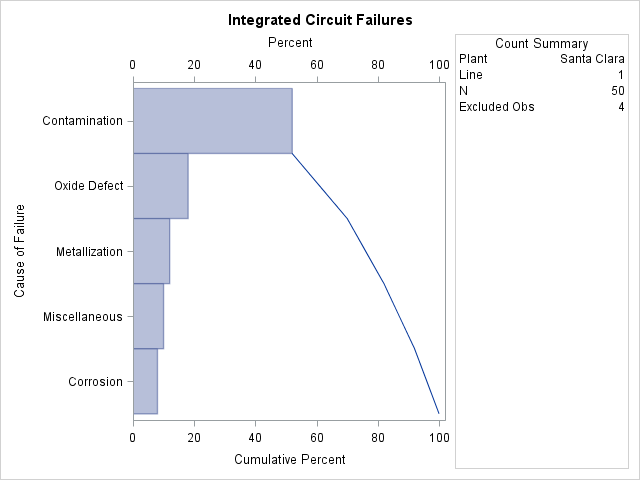The PARETO Procedure
- Overview
-
Getting Started

-
Syntax

-
Details

-
Examples
 Creating Before-and-After Pareto ChartsCreating Two-Way Comparative Pareto ChartsHighlighting the Vital FewHighlighting Combinations of CategoriesHighlighting Combinations of CellsOrdering Rows and Columns in a Comparative Pareto ChartMerging Columns in a Comparative Pareto ChartCreating Weighted Pareto ChartsCreating Alternative Pareto ChartsCustomizing Inset Labels and Formatting ValuesSpecifying Inset Headers and PositionsManaging a Large Number of Categories
Creating Before-and-After Pareto ChartsCreating Two-Way Comparative Pareto ChartsHighlighting the Vital FewHighlighting Combinations of CategoriesHighlighting Combinations of CellsOrdering Rows and Columns in a Comparative Pareto ChartMerging Columns in a Comparative Pareto ChartCreating Weighted Pareto ChartsCreating Alternative Pareto ChartsCustomizing Inset Labels and Formatting ValuesSpecifying Inset Headers and PositionsManaging a Large Number of Categories - References
Note: See Specifying Inset Headers and Positions in the SAS/QC Sample Library.
By default, the first INSET statement that is specified after a chart statement displays an inset in the upper left corner of the chart. You can control the inset position by specifying the POSITION= option. In addition, you can display a header at the top of the inset by specifying the HEADER= option. The following statements create a data set to be used with the INSET DATA= keyword and produce the horizontal Pareto chart shown in Output 15.11.1:
data location; length _LABEL_ $ 10 _VALUE_ $ 12; input _LABEL_ _VALUE_ &; datalines; Plant Santa Clara Line 1 ;
title 'Integrated Circuit Failures';
proc pareto data=Failure3;
hbar Cause /
freq = Counts
maxncat = 5
odstitle = title;
inset data = location n nexcl /
position = rm
header = 'Count Summary';
run;
The header (in this case, “Count Summary”) can be up to 40 characters. The POSITION=RM option is specified to position the inset in the right margin so that it does not interfere with features of the chart. For more information about positioning, see the section Positioning Insets.
INSET statement options, such as the POSITION= and HEADER= options, are specified after the slash (/). For more information about INSET statement options, see the section INSET Statement Options.
Note that the contents of the data set location appear before other statistics in the inset. The position of the DATA= keyword in the keyword list determines the position
of the data set’s contents in the inset.
